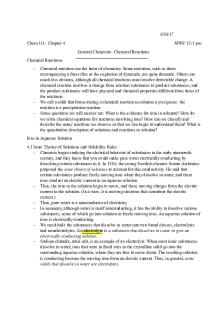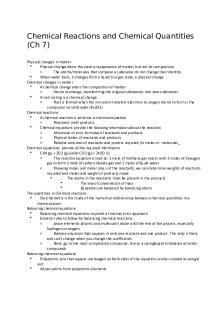CHEM 1211K - Observing Chemical Reactions Lab PDF

| Title | CHEM 1211K - Observing Chemical Reactions Lab |
|---|---|
| Author | Brad Herrick |
| Course | Basics Of Chemistry |
| Institution | University of Georgia |
| Pages | 4 |
| File Size | 147.3 KB |
| File Type | |
| Total Downloads | 7 |
| Total Views | 159 |
Summary
lab 01...
Description
Observing Chemical Reactions Introduction Today’s experiment focuses on how to recognize and document the clues that indicate that a chemical reaction has occurred. There are several different observations that may indicate a chemical reaction has taken place: (1) Formation of a precipitate (solid) (2) Color change within a solution (3) Gas evolution (4) Heat evolution / absorption When documenting a chemical reaction, it is important to include enough details so that another researcher could recognize the same reaction. Consider the following observation regarding a chemical reaction: “Upon mixing the two reagents, the solution turned blue and hydrogen gas was produced.” Many students might consider this sufficiently detailed to illustrate the chemical reaction. However, it leaves out many important details – what color was each reagent originally? How do we know hydrogen gas was produced? Was a precipitate formed? To properly describe a chemical reaction in sufficient detail, it is important to describe the appearance of all reagents before, during, and after the reaction takes place, and to describe any sounds, smells, heat, etc. that accompany the reaction. A more detailed version of the above description might state: "Both reagents were initially clear. Upon mixing, the solution turned a light blue color, but did not produce any precipitate. Mixing also resulted in gas evolution. Testing the gas with a lit splint produced a "pop" sound, indicating that the gas was hydrogen." It is also important to use proper scientific terminology when describing chemical reactions. The following terms are used to describe chemical reactions in the laboratory: If a solid is formed from a mixture of two aqueous solutions, this is called a precipitate. When a solution looks “milky” or cloudy it is generally evidence that a precipitate has been formed. If two solutions start to bubble upon mixing, this indicates a gas is being formed – this is referred to as gas evolution. If a solution heats up or cools down, this is referred to as heat evolution or heat absorption, respectively. In addition to recognizing the signs of chemical reactions in a test tube, it is useful to represent chemical reactions on paper. Written chemical equations follow the general format: Reactants (phase) → Products (phase) where reactants are on the left, the arrow indicates a reaction has taken place, and the products are on the right. The phase (solid, liquid, gas, or aqueous) of each reactant or product is shown in parentheses. (Note: aqueous means that the substance is dissolved in water, and therefore not a pure liquid.) Chemical reactions must also be balanced, so that the reaction has the same number of each element on each side of the equation. This is done by adding coefficients in front of molecules. An example of a balanced chemical reaction is: 4 HCl(aq) + O2(g) → 2 H2O(l) + 2 Cl2(g) Objectives 1. recognize when a chemical reaction has occurred 2. collect detailed observations in the laboratory using proper scientific terms STEM Skills Practiced in this Experiment 1. Scientific Communication – record detailed observations using scientific terminology 2. Data Analysis – use experimental observations to classify reactions 1
3. Problem Solving – balance chemical equations
2
Procedure Each of today’s procedures will be conducted in medium test tubes; obtain ten of these and place them in the test tube rack. For each of the procedures below, record DETAILED observations that provide evidence for a chemical reaction (initial color of the solutions, final color of solution, color of precipitate formed (if any), sounds, heat evolved/absorbed, gases evolved, etc.). Reaction Set #1 (1a) Place approximately 1 mL of 0.1 M Pb(NO 3)2 solution in a test tube. Then sequentially add drops of 0.25 M K2CrO4 solution until you see evidence of a chemical reaction. (1b)
Place approximately 1 mL of 0.1 M Pb(NO 3)2 solution in a test tube. Then sequentially add drops of 0.25 M Na2SO4 solution until you see evidence of a chemical reaction.
Reaction Set #2 Helpful Experimental Notes: These reactions should each form one of three gases – hydrogen, oxygen, or carbon dioxide. For the purposes of this experiment, the following tests will allow for the identification of each gas: o Hydrogen: Place a lit wooden splint into the test tube, and the hydrogen gas will ignite with a soft ‘pop’. o Oxygen: Place a glowing splint into the test tube, and the oxygen will relight the splint and/or cause it to glow brighter. o Carbon dioxide: Place a lit splint into the test tube, and the flame will be extinguished. It is important that the gas-evolution tests be performed while the reaction is still actively forming gas. (2a)
Place 1 mL of 6M HCl into a test tube, and add in a small piece of magnesium.
(2b)
Place 1 mL of 3% hydrogen peroxide into a test tube, and add in a bit of KMnO 4 solid on the tip of a spatula (or add a drop of KMnO4 solution, whichever is available).
(2c)
Place 1 mL of vinegar (dilute HC2H3O2) into a test tube and add in a spatula tip of NaHCO3.
Reaction Set #3 (3a) Place 2 mL of 6 M NaOH into a test tube. Add 2 mL of 6 M HCl to the test tube containing NaOH and mix. (3b)
Place 2 mL of distilled water into a test tube, and add in ~0.5 g (record all digits displayed) of NH 4Cl. Mix the reactants.
Clean Up Dispose of all solutions and precipitates in the Hazardous Waste Container. You may need to rinse material out of the test tubes or spot plate by using a water squirt bottle. Wash and rinse all test tubes used and place into your test tube rack upside down to drip dry once they are returned to your drawer (Only if a test tube is badly stained should it be disposed of in the broken glass container located in the lab). Make sure to wipe down your work space and return all other cleaned glassware to the correct locations within your drawers. Do not leave drying glassware by the sinks.
3
Calculations 1. Provide balanced chemical equations for each of the chemical reactions that you performed. [Reaction (2b) is omitted here.] (1a) _______ Pb(NO3)2 (aq) + ________ K2CrO4 (aq) → ________ KNO3 (aq) + ________ PbCrO4 (s) (1b) _______ Pb(NO3)2 (aq) + ________ Na2SO4 (aq) → ________ NaNO3 (aq) + ________ PbSO4 (s) (2a) _______ HCl (aq) + ________ Mg (s) → ________ MgCl2 (aq) + ________ H2 (g) (2c) _____ HC2H3O2 (aq) + ______NaHCO3 (s) → ______ NaC2H3O2 (aq) + _____ H2O (l) + _____ CO2(g) (3a) _______ NaOH (aq) + ________ HCl (aq) → ________ NaCl (aq) + ________ H2O (l) (3b) _______ NH4Cl (s) → ________ NH4+ (aq) + ________ Cl– (aq) Analysis & Discussion 1. Which of the above reactions can be classified as precipitation reactions? 2. Which of the above reactions can be classified as gas evolution reactions? 3. Which of the above reactions had non-visual clues that a reaction had taken place? In this case, what indicated that a chemical reaction had occurred? Conclusion Summarize the lab by answering the following questions in your lab notebook. Check with your instructor to see whether you should just respond to the questions or if you should place your responses in a single paragraph. 1. What was the main topic/concept investigated in the lab? 2. How was this concept investigated? 3. What were the main results found in this experiment?
4...
Similar Free PDFs

Lab Experiment 4- Chemical Reactions
- 10 Pages

Chem 111 Ch 4 Chemical Reactions
- 17 Pages

Bill Nye Chemical Reactions
- 2 Pages

Rates of Chemical Reactions
- 9 Pages

Types of chemical reactions
- 4 Pages

Chapter 15 Chemical Reactions
- 21 Pages

Chemical reactions equations
- 6 Pages
Popular Institutions
- Tinajero National High School - Annex
- Politeknik Caltex Riau
- Yokohama City University
- SGT University
- University of Al-Qadisiyah
- Divine Word College of Vigan
- Techniek College Rotterdam
- Universidade de Santiago
- Universiti Teknologi MARA Cawangan Johor Kampus Pasir Gudang
- Poltekkes Kemenkes Yogyakarta
- Baguio City National High School
- Colegio san marcos
- preparatoria uno
- Centro de Bachillerato Tecnológico Industrial y de Servicios No. 107
- Dalian Maritime University
- Quang Trung Secondary School
- Colegio Tecnológico en Informática
- Corporación Regional de Educación Superior
- Grupo CEDVA
- Dar Al Uloom University
- Centro de Estudios Preuniversitarios de la Universidad Nacional de Ingeniería
- 上智大学
- Aakash International School, Nuna Majara
- San Felipe Neri Catholic School
- Kang Chiao International School - New Taipei City
- Misamis Occidental National High School
- Institución Educativa Escuela Normal Juan Ladrilleros
- Kolehiyo ng Pantukan
- Batanes State College
- Instituto Continental
- Sekolah Menengah Kejuruan Kesehatan Kaltara (Tarakan)
- Colegio de La Inmaculada Concepcion - Cebu








